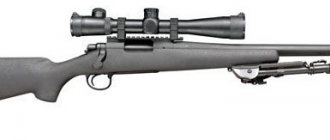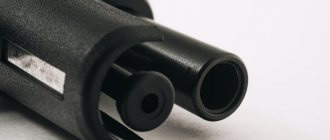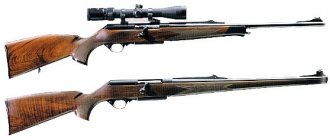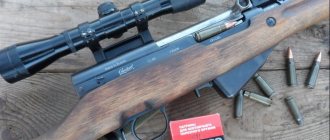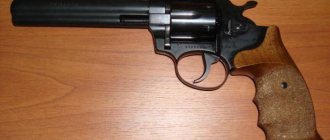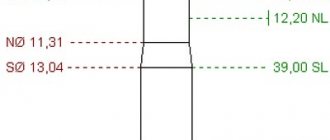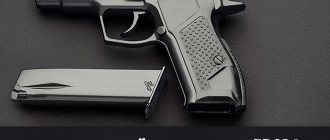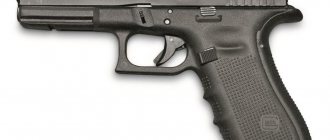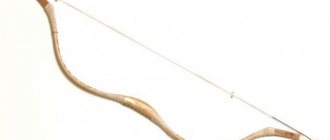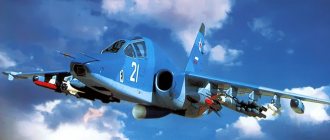Not so long ago, at one of the annual forums of modern weapons “Army”, a fresh example of the domestic military industry was presented. This is a brand new SHF 308 rifle - the brainchild of the Kalashnikov Concern. She created a real sensation among the presented models and was awarded the attention of the President of the Russian Federation himself. What characteristics does it have and what is its secret?
History of creation
This weapon is the final development of the “Warrior” project because it took part in a competition for the development of a new semi-automatic sniper rifle. The SVD rifle was to be taken as the basis, but soon the designers realized that the new weapon based on this rifle would no longer meet modern trends and requirements: high accuracy of fire, high ergonomic characteristics, and the ability to use modern heavy sighting devices. For example, in SVD and AK sights are mounted on the side rail, which limits the shooter’s use of other sights and there is no 100% chance of returning the sight line.
Chukavina microwave rifle
When developing the designer, they decided not to limit themselves to the possibility of using only 7.62 mm cartridges.
As for the design of the weapon, it is far from new, but borrowed from the previously developed SVK.
A brief history of the microwave rifle and name change
Calling a sample a fundamentally new model is incorrect for a number of reasons. The Chukavin microwave sniper rifle is designed on the basis of the SVK, presented a year earlier at the same Army exhibition (Figure 3).
It has a similar upper part and receiver with an upper and lower receiver and is largely recreated according to the Western prototype of the famous American M16 model.
Among the representatives of the line, the SHF 338 rifle is of particular interest in this regard, which managed to take a step forward compared to other models.
In both cases, the project was led by one person - Andrei Yuryevich Chukavin, whose name is included in the name of the weapon.
Figure 3. Rifles that served as the basis for the microwave
The catalyst for his work was the decision that the SVD, adopted for service in 1963, cannot fully meet the modern requirements of the military and those generally imposed on such products. It took into account the critical remarks that concerned Dragunov’s invention - the large length, the lack of promising calibers and the inability to use current optics.
Design
The design of the rifle is based on the little-known small-sized machine gun of Dragunov E.F. (automatic MA), developed back in 1973 and is a curtain circuit. With this arrangement, all the main elements of the weapon are mounted on a strong and durable upper rail with guides, 10 mm thick. All other elements can be unloaded and made of plastic or light alloys. In the classic SVD and AK designs, there are no upper guides, and the bolt frame moves along the lower ones. Here it’s the other way around - the bolt carrier and bolt move along the top rail.
Chukavina microwave rifle
A massive barrel, made by rotational forging, is attached to the tire through a liner, being a single rigid assembly. Apart from the gas chamber, there is no barrel fittings on the microwave barrel
The lower part of the rifle (usually aluminum, but can be made of composite materials) contains the trigger housing with the safety and the base with the magazine receptacle.
The automatic weapon operates on the principle of removing powder gases with a short piston stroke and is borrowed from the reliable system of the Dragunov rifle. The rifle has a manual gas regulator.
Ammunition for weapons today is carried out with classic 7.62x54 mm cartridges, 7.62x51 mm cartridges (known abroad as .308 Win) and 8.6x70 mm ammunition (.338 caliber). The weapon uses a well-known and reliable SVD magazine with a capacity of 10 rounds. There are also magazines for 15 and 20 rounds.
Chukavina microwave rifle
This is interesting: the microwave rifle has a huge number of analogues abroad.
The microwave rifle safety is located on both sides of the weapon, which ensures maximum ease of use of the weapon.
The rifle has a folding telescopic buttstock with an adjustable cheekpiece.
Classics of the genre
The Dragunov sniper rifle has been in service for more than half a century. Back in 1963, the SVD's competitors were the designs of Simonov and Konstantinov. The Dragunov sniper rifle prevailed due to its reliability, simplicity of design and high accuracy. The rifle’s ability to “work” reliably under the most unfavorable conditions and in any combat situations was also noted.
Reference
It is a common misconception that the Dragunov rifle is a modification of the Kalashnikov assault rifle, since they have almost the same automatic operation scheme, the principle of removing powder gases, as well as a noticeable similarity in appearance. But that's not true. The designs of AK and SVD differ significantly. First of all, this concerns moving parts - the bolt frame of a Kalashnikov assault rifle is connected to a piston, and when firing, most of the “internal structure” begins to move. When firing an SVD, only the bolt frame moves, which significantly affects the shooting accuracy.
It should be noted that bolt-action sniper rifles are common in the armies of the world, for example, the American M24 (and its recent modification XM2010) or the British L96A1. This is due to the fact that self-loading rifles have noticeably worse shooting characteristics or an overly complex design. But it should be understood that Western-made self-loading rifles are considered either support weapons or police weapons, for example, the German PSG1, which was specially created after the terrorist attack at the Munich Olympics.
Despite the fact that the SVD is self-loading, the designers managed to ensure both simplicity of automation and high shooting accuracy, close to non-automatic counterparts, even at long range. This was confirmed during the Afghan campaign, when the sniper of the 345th Guards Parachute Regiment Vladimir Ilyin hit the target from a distance of 1,350 meters and set a record for semi-automatic rifles of 7.62 mm caliber. But the main task of the SVD is to provide effective fire to a motorized rifle squad at a range of up to 600 meters.
The SVD uses a 7.62 mm caliber cartridge, and at first they used conventional machine guns, which could not provide sufficient shooting accuracy. In 1967, a special 7N1 sniper cartridge was developed, the key feature of which is high accuracy. However, this was the end of the experiments with ammunition and were no longer carried out.
And the design of the Dragunov rifle has not undergone significant changes over half a century that could affect its effectiveness. At the same time, the requirements for a modern sniper rifle increased. In particular, new sights appeared, but the Dragunov rifle was not going to be “friendly” with modern optics - the side rail could not protect the sight from unwanted vibrations. Therefore, the sniper was “tied” to standard optics - the PSO-1 sight. It was also noted that the SVD, by modern standards, has a too long barrel. But all attempts by the developers of the Kalashnikov concern to update the design of the SVD only delayed the fatal moment. Therefore, the decision was made to create a fundamentally new rifle.
Pros and cons of weapons
There are different opinions regarding this weapon. Many experts are confused by the “short” barrel length of the Chukavina rifle. It is 410 mm (for SVD it is 550 mm). And this is unlikely to be able to provide decent characteristics of a microwave rifle, because you can’t argue with physics and ballistics.
The second negative point is that the trigger of the weapon requires close attention and careful care, which cannot be said about the SVD rifle, where work was allowed even with heavy contamination.
In addition to the negative aspects, microwaves also have a number of positive aspects. One of them is the fact that the rifle was designed as a universal weapon for a wide variety of situations: from single, accurate shooting at long distances to close-combat shooting.
Chukavina microwave rifle
It is also important that the weapon has a fairly light weight - only 4200 g (a similar weapon weighs about 7 kg) due to the use of various alloys in the design.
The undoubted advantage of the rifle is its extreme ease of cleaning and maintenance. Here, as with the SVK, in order to get to the trigger, it is enough to break the box, and after disassembly you will not have to adjust the installed optics as in traditional weapons.
The microwave has low, soft recoil and high firing accuracy due to the fact that the barrel and butt are on the same line. The rifle provides a high rate of fire.
The Picatinny rail along the entire length of the receiver allows you to install absolutely any attachment - from optical sights to laser sights, night vision devices and more.
The high ergonomics of the weapon are also impressive: it is very convenient to unfasten the magazine both in the classical way and with the index finger; The reloading handle is located on the left, which improves ease of use when lying down.
Chukavina microwave rifle
According to the general director, microwave production is planned to begin in 2020.
Problems to be solved
This weapon is primarily intended for use in combined arms units by highly qualified shooters.
In English-speaking countries they are called designated marksman, which loosely translated means “infantry sniper.”
Microwave.
Image source, YouTube website of the Kalashnikov concern The rifle is designed to guarantee the destruction of a potential enemy at medium and short distances during combined arms combat. The overall dimensions of the new weapon allow the sniper to use only it in battle. This increases mobility.
But, when creating it, the design team focused on other tasks, to create a universal platform for working on the entire line of promising small arms of the concern.
The structure of the MP-1 rifle
The design of the MR1 self-loading carbine is based on a gas engine - part of the powder gases generated during a shot is spent not on releasing the bullet, but on opening the bolt, pushing out the spent cartridge case and feeding new ammunition from the magazine into the chamber. However, a similar system is present in most rifles from the Kalashnikov concern, so we’d rather talk about those features that distinguish the civilian modification of the microwave from the general background:
- The pistol-shaped grip is an unusual solution for a sniper weapon, but it is thanks to it that the ergonomics of the weapon have been improved. The model’s grip is much more comfortable than that of the same “Saiga” with a semi-pistol grip.
- The Picatinny sighting rail (22 mm) integrated into the receiver allows you to install a modern body kit on the weapon (optics, collimators, holographic sights, night vision devices, thermal imagers), including foreign ones.
- Double-sided safety lever with 2 positions: “single fire” and “safety”. Such a device will be equally convenient for both right-handed and left-handed people.
- Aluminum stock SAG - can be folding or static (depending on the version). It is also possible to adjust the position of the part (5 gradations for adjustment) and change the length by installing a rubber butt of different shapes.
- The presence of three lugs designed to lock the barrel - such a system not only increases the safety indicator of weapon operation, but also significantly reduces the time required for reloading.
- Chrome-plated barrel bore and chamber is not a new technology, but it was in the MR1 that it was brought to near perfection. The weapon can withstand energy up to 7000 J, so the likelihood of the barrel rupturing is negligible.
- The presence of an M18x1 thread in the muzzle of the barrel allows you to install various useful devices on the weapon: flash suppressors, sound moderators (silencers), muzzle brake compensators, etc.
The appearance of the MR1 self-loading carbine is very different from everything that the Kalashnikov concern has produced previously. The weapon began to look more like tactical American and European rifles (based on a U-shaped steel box, on top of which a composite polymer stock is attached). However, this does not mean that the army version of the microwave will look exactly the same.
